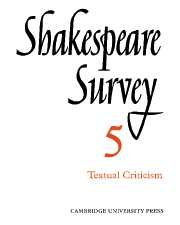Book contents
- Frontmatter
- Restoring Shakespeare: The Modern Editor’s Task
- Suggestions Towards an Edition of Shakespeare for French, German and Other Continental Readers
- The 1622 Quarto and the First Folio Texts of Othello
- An Approach to the Problem of Pericles
- The Shakespeare Collection in the Library of Trinity College, Cambridge
- New Place: The Only Representation of Shakespeare’s House From an Unpublished Manuscript
- Letters to an Actor Playing Hamlet
- Shakespeare’s Imagery: The Diabolic Images in Othello
- Suggestions for a New Approach to Shakespeare’s Imagery
- Shakespeare’s Influence on Pushkin’s Dramatic Work
- Shakespeare on the Flemish Stage of Belgium, 1876–1951
- International Notes
- Shakespeare Productions in the United Kingdom: 1950
- Shakespeare in the Waterloo Road
- The Year's Contributions to Shakespearian Study 1 Critical Studies
- 2 Shakespeares’s Life, Times and Stage
- 3 Textual Studies
- Books Received
- Index
- Plates
2 - Shakespeares’s Life, Times and Stage
Published online by Cambridge University Press: 28 March 2007
- Frontmatter
- Restoring Shakespeare: The Modern Editor’s Task
- Suggestions Towards an Edition of Shakespeare for French, German and Other Continental Readers
- The 1622 Quarto and the First Folio Texts of Othello
- An Approach to the Problem of Pericles
- The Shakespeare Collection in the Library of Trinity College, Cambridge
- New Place: The Only Representation of Shakespeare’s House From an Unpublished Manuscript
- Letters to an Actor Playing Hamlet
- Shakespeare’s Imagery: The Diabolic Images in Othello
- Suggestions for a New Approach to Shakespeare’s Imagery
- Shakespeare’s Influence on Pushkin’s Dramatic Work
- Shakespeare on the Flemish Stage of Belgium, 1876–1951
- International Notes
- Shakespeare Productions in the United Kingdom: 1950
- Shakespeare in the Waterloo Road
- The Year's Contributions to Shakespearian Study 1 Critical Studies
- 2 Shakespeares’s Life, Times and Stage
- 3 Textual Studies
- Books Received
- Index
- Plates
Summary
In further illustration of Shakespeare as a “learned grammarian” T. W. Baldwin has turned to the non-dramatic poems and has explored in characteristic detail his debt to Ovid and the Renascence commentators. But in addition, by considering together passages from the poems and the plays where Shakespeare uses the same image, Baldwin tries to arrange them in chronological order on the assumption that the simpler form of the image and the less condensed expression will “almost certainly” be the earlier. Thus in Venus and Adonis the young man is anxious to keep “a false sond” from entering “the quiet closure of my breast”, which he calls the “bedchamber” of his heart; in Richard III Rivers, invoking Pomfret Castle, refers to the murder of Richard II “Within the guilty closure of the walls”; in Sonnet 48 “the gentle closure of my breast” is a prison, as in Richard III, in which the loved one can come and go at will. Although the verbal resemblance is greatest between Venus and Adonis and Sonnet 48, Baldwin believes that the Richard III passage intervened, introducing into the image the notion of prison. Evidence is thus produced for the dating of Sonnets and the early plays. The Sonnets are shown to have been written during the years 1593–9, and to have comprised six approximately equal series of some twenty-five sonnets each: each series would fill a quire of paper, and would be accompanied by one or more dedicatory sonnets. Baldwin accepts Southampton as the patron, but rejects the notion that the poet’s personal history is recorded. The Dark Lady is “a literary paradox”, close companion to Rosaline and Phoebe. It is perhaps significant that he has little to say on Sonnet 129.
- Type
- Chapter
- Information
- Shakespeare Survey , pp. 137 - 144Publisher: Cambridge University PressPrint publication year: 1952

